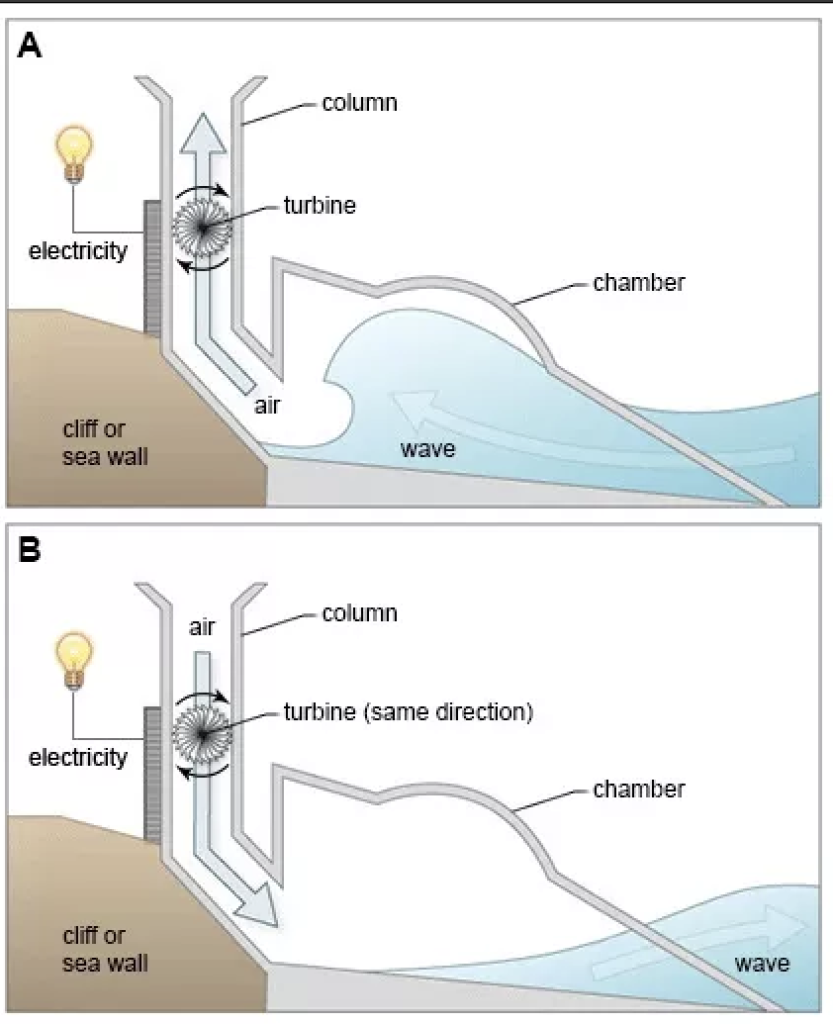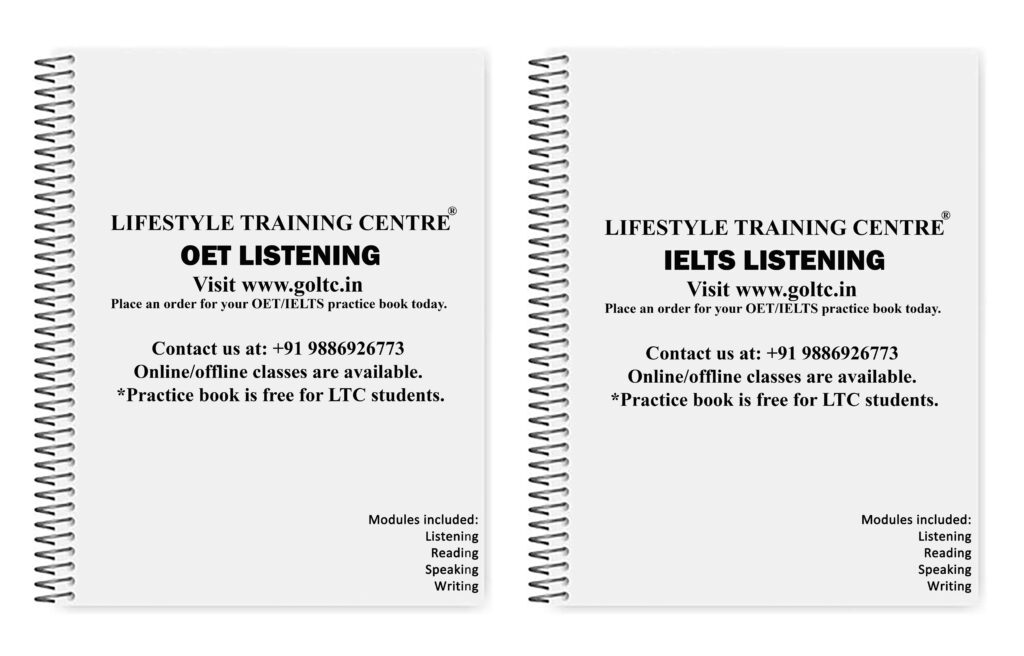4. IELTS process diagram. Generating electricity from wave.
The diagrams below show a structure that is used to generate electricity from wave power. Summarise the information by selecting and reporting the main features, and make comparisons where relevant.

Model answer by Lifestyle Training Centre – Band 9
The provided process diagram meticulously illustrates the complex mechanisms, components, and steps that are involved in harnessing tidal wave energy, for the production of clean electricity.
As a whole, the process encompasses tidal waves, a conduit chamber, a column, and a turbine that rotates and produces electricity. While the first image showcases how electricity is produced using flood tide, the second, ebb tide.
The Flood tide, channelled through the chamber, as it moves toward the shore, pushes out the trapped air in the connected column, which is built on a cliff or sea wall. Consequently, a turbine located in the middle of the column rotates clockwise, inducing the production of electricity.
In contrast, during ebb tide, the receding tidal waves create a vacuum within the chamber. As a result, the air inside moves downward, driving the turbine clockwise and generating electricity. The generated electricity can then be harvested and used.
(Word count: 150)
List of vocabulary used:
- Diagram – a visual representation of information.
- Meticulously – with great attention to detail.
- Illustrates – explains or shows by example.
- Complex – consisting of many different and connected parts; complicated.
- Mechanisms – the processes or systems that perform a function.
- Components – parts or elements that make up a whole.
- Harnessing – capturing and using a resource.
- Tidal wave – a large sea wave caused by the gravitational pull of the moon and sun.
- Energy – the capacity to do work or produce change.
- Production – the process of creating something.
- Electricity – a form of energy resulting from the flow of electric charge.
- Conduit – a channel for conveying water or other fluids.
- Chamber – an enclosed space or compartment.
- Column – a vertical structure that supports weight.
- Turbine – a machine that converts fluid energy into mechanical energy.
- Rotates – turns around an axis or center.
- Clockwise – in the direction of the hands of a clock.
- Inducing – causing or bringing about.
- Ebb tide – the period when the tide is receding or falling.
- Receding – moving back or away.
- Vacuum – a space devoid of matter.
- Driving – causing or forcing something to move.
- Harvested – collected for use or consumption.
- Generated – produced or created.
IELTS Speaking Task Topics
Click on any topic to explore more!
Names

Learn about the importance of names and their cultural significance.
Study / Job

Discuss various aspects of studying and working in different fields.
Hometown

Explore the charm of your hometown and its unique features.
Accomodation

Understand various types of accommodation and living situations.
Weather

Learn about how weather influences daily life and activities.
Time

Discuss the concept of time, its importance, and time management.
Television

Talk about the role of television in modern entertainment.
Museum

Discuss the cultural importance of museums and historical exhibits.
Holidays

Explore the significance of holidays and different celebrations.
Films

Learn about the impact of films on culture and society.
Leisure Time

Discuss how leisure activities impact personal well-being.
Sport

Talk about the role of sports in health, entertainment, and culture.
Vegetables and Fruits

Discuss the health benefits and importance of fresh produce.
Maths

Explore the role of mathematics in various aspects of life.
Sky

Discuss the beauty and scientific significance of the sky.
Clothes&Fashion

Explore how clothing reflects culture and personal expression.
Weekend

Discuss the importance of weekends and ways people relax.
Reading

Learn about the importance of reading and various reading habits.
Sleep

Explore how sleep impacts physical and mental well-being.
Trees&Plants

Discuss the environmental and health benefits of plants.
Newspaper

Discuss the evolving role of newspapers in the digital age.
Texting

Explore the role of text messaging in modern communication.
Memorising

Learn techniques for improving memory and memorization.
Travelling

Discuss the importance and impact of traveling in modern society.
Communication

Explore the modes and significance of communicating well
Letter&Email

Explore the differences and significance of letters vs. emails.
Swimming

Discuss the benefits of swimming for health and fitness.
Snacks

Explore the role of snacks in daily nutrition and lifestyle.
Photography

Discuss photography’s cultural and artistic significance.
Help

Talk about the importance of offering and receiving help.
History

Discuss historical events and their impact on modern society.
Handwriting

Explore the significance of handwriting in education and culture.
Music

Learn about the influence of music on emotions and society.
Colours

Discuss how colours affect perception and mood.
Teachers

Explore the role of teachers in shaping students’ futures.
Being Alone

Talk about the experience and benefits of spending time alone.
Teamwork

Learn the importance of teamwork in professional and social contexts.
Countryside & City

Explore the charm and benefits of living in the countryside.
Social Media

Discuss the impact of social media on society and relationships.
Friends

Explore the importance of friendships in life.
Artificial Intelligence (AI)

Talk about the future of AI and its role in society.
Climate Change

Discuss the causes and consequences of climate change.
Transportation

Explore different modes of transportation in your area.
Sustainable Transportation

Explore ways to make transportation more environmentally friendly.
Space Exploration

Learn about the latest advancements in space exploration.
Shopping

Explore how shopping influences culture and the economy.
Modern Technology

Discuss how modern technology is reshaping society.
Technology

Learn about the role of technology in everyday life.
Sustainable Living

Explore ways to live sustainably for the future of the planet.
Globalisation

Learn about the effects of globalisation on society and economies.
Global Warming

Discuss the causes, effects, and solutions to global warming.
Gender Equality

Explore the importance of gender equality in modern society.
Health and Fitness

Discuss the importance of maintaining a healthy lifestyle.
Renewable Energy

Learn about renewable energy sources and their impact on the environment.
Cultural Traditions in Kerala

Explore the unique cultural traditions of Kerala, your hometown.
Cultural Traditions in Your Country

Learn about the cultural traditions in your country.
Education System

Discuss the education system in your country and its effectiveness.
Traditional Cuisine

Explore the significance of traditional cuisines in your culture.
Do you need printed IELTS/ OET practice material? Place your order today. Available now for just Rs: 1,100 (including shipping all across India) Contact us at our WhatsApp number: +91 9886926773 to place your order. (Free for LTC students)

We hope this information has been valuable to you. If so, please consider a monetary donation to Lifestyle Training Centre via UPI. Your support is greatly appreciated.

Would you like to undergo training for OET, PTE, IELTS, Duolingo, Phonetics, or Spoken English with us? Kindly contact us now!
📱 Call/WhatsApp/Text: +91 9886926773
📧 Email: mail@goltc.in
Visit us in person by following the directions on Google Maps. We look forward to welcoming you to the Lifestyle Training Centre.
Follow Lifestyle Training Centre on social media:
Thank you very much!
